23 apr 2018
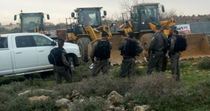
Five locations in Israel on Monday caught fire due to four kites affixed with flaming materials sent from Gaza Strip over the borderline east of . The fire ate wide swathes of wheat fields in southern Israel.
The burning kites are part of a new tactic utilized by Gazan protesters against Israel as part of the ongoing weekly demonstrations of the “Great March of Return” along the borderline.
The burning kites are part of a new tactic utilized by Gazan protesters against Israel as part of the ongoing weekly demonstrations of the “Great March of Return” along the borderline.
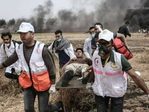
Israeli soldiers shot, on Monday evening, one Palestinian east of Khan Younis, in the southern part of the Gaza Strip, and abducted four teenage boys, east of the al-Boreij refugee camp, in central Gaza.
Media sources said the soldiers, stationed across the border fence, east of Khuza’a town, east of Khan Younis, shot a young man with live fire, before he was rushed by local medics to a Palestinian hospital.
In related news, the soldiers abducted four teenage boys, east of the al-Boreij refugee camp, reportedly after they crossed the border fence.
It is worth mentioning that the army pushed more soldiers, and armored vehicles across the border fence.
Media sources said the soldiers, stationed across the border fence, east of Khuza’a town, east of Khan Younis, shot a young man with live fire, before he was rushed by local medics to a Palestinian hospital.
In related news, the soldiers abducted four teenage boys, east of the al-Boreij refugee camp, reportedly after they crossed the border fence.
It is worth mentioning that the army pushed more soldiers, and armored vehicles across the border fence.
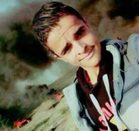
Tahrir Mahmoud Wahba, 18
The Palestinian Health Ministry has reported that a Palestinian teenager died, Monday, from very serious wounds he suffered, on April 1st, after Israeli soldiers shot him during a nonviolent protest near the border fence, in Khuza’a village, east of Khan Younis, in the southern part of the Gaza Strip.
The Ministry said the Palestinian, Tahrir Mahmoud Wahba, 18, was shot in the head during a nonviolent procession, and remained in a very serious condition until his death at the European Hospital, in Khan Younis, in the southern part of the Gaza Strip.
The Palestinian, who is also deaf and cannot speak, was shot near the border fence east of Khuza’a town, east of Khan Younis. He was from Tal al-Sultan area, in nearby Rafah.
“My son cannot speak or hear, and I frequently tried to prevent him from protesting near the border area,” his mother said, “But he would get angry, and shake his head, refusing to stay home, and insisting on being part of the struggle.”
On Sunday at night, a young man, identified as Abdullah Mohammad Shamali, 20, from al-Barazil neighborhood, in Rafah died from serious wounds he suffered after Israeli soldiers shot him, Friday, April 27th.
The Health Ministry stated that the soldiers have killed 39 Palestinians, and injured more than 5000, including 138 who suffered serious wounds, since the “Great March of Return” protests started on Palestinian Land Day, on March 30th, 2018.
The Palestinian Health Ministry has reported that a Palestinian teenager died, Monday, from very serious wounds he suffered, on April 1st, after Israeli soldiers shot him during a nonviolent protest near the border fence, in Khuza’a village, east of Khan Younis, in the southern part of the Gaza Strip.
The Ministry said the Palestinian, Tahrir Mahmoud Wahba, 18, was shot in the head during a nonviolent procession, and remained in a very serious condition until his death at the European Hospital, in Khan Younis, in the southern part of the Gaza Strip.
The Palestinian, who is also deaf and cannot speak, was shot near the border fence east of Khuza’a town, east of Khan Younis. He was from Tal al-Sultan area, in nearby Rafah.
“My son cannot speak or hear, and I frequently tried to prevent him from protesting near the border area,” his mother said, “But he would get angry, and shake his head, refusing to stay home, and insisting on being part of the struggle.”
On Sunday at night, a young man, identified as Abdullah Mohammad Shamali, 20, from al-Barazil neighborhood, in Rafah died from serious wounds he suffered after Israeli soldiers shot him, Friday, April 27th.
The Health Ministry stated that the soldiers have killed 39 Palestinians, and injured more than 5000, including 138 who suffered serious wounds, since the “Great March of Return” protests started on Palestinian Land Day, on March 30th, 2018.
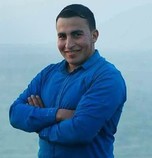
Abdullah Mohammad Shemaly, 20
A Palestinian youth died on Sunday of wounds sustained from shots fired by Israeli soldiers during the Great March of Return protests staged at the Gaza border.
Abdullah Mohammad Shemaly, 20, was shot and critically injured by Israeli bullet fire in his chest on Friday. He was admitted to the Gaza European Hospital until he succumbed to his wounds on Sunday night.
40 Palestinians have been killed by Israeli forces at Gaza’s border since the launch of the Great March of Return protests on March 30. Over 4,500 others have been left wounded.
A Palestinian youth died on Sunday of wounds sustained from shots fired by Israeli soldiers during the Great March of Return protests staged at the Gaza border.
Abdullah Mohammad Shemaly, 20, was shot and critically injured by Israeli bullet fire in his chest on Friday. He was admitted to the Gaza European Hospital until he succumbed to his wounds on Sunday night.
40 Palestinians have been killed by Israeli forces at Gaza’s border since the launch of the Great March of Return protests on March 30. Over 4,500 others have been left wounded.
22 apr 2018
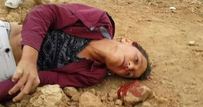
An Israeli General Reserve Zvika Vogel said that Israeli occupation forces (IOF) stationed at the borderline with Gaza deliberately kill Palestinian children who participate in protests based on clear specific orders.
The General’s remarks are considered as a condemnation that can be submitted to International Criminal Court in order to prosecute Israel.
The last Palestinian child that was intentionally murdered by IOF soldiers was Mohammad Ayoub, 15, who was killed last Friday east of Jabalya in the eastern Gaza Strip during his participation in the Great March of Return. He was killed by a sniper while running away along with other group of children.
Snipers ordered to shoot children, Israeli general confirms
The General’s remarks are considered as a condemnation that can be submitted to International Criminal Court in order to prosecute Israel.
The last Palestinian child that was intentionally murdered by IOF soldiers was Mohammad Ayoub, 15, who was killed last Friday east of Jabalya in the eastern Gaza Strip during his participation in the Great March of Return. He was killed by a sniper while running away along with other group of children.
Snipers ordered to shoot children, Israeli general confirms

Zvika Fogel
An Israeli general has confirmed that when snipers stationed along Israel’s boundary with Gaza shoot at children, they are doing so deliberately, under clear and specific orders.
In a radio interview, Brigadier-General (Reserve) Zvika Fogel describes how a sniper identifies the “small body” of a child and is given authorization to shoot.
Fogel’s statements could be used as evidence of intent if Israeli leaders are ever tried for war crimes at the International Criminal Court.
On Friday, an Israeli sniper shot dead 14-year-old Muhammad Ibrahim Ayyoub.
The boy, shot in the head east of Jabaliya, was the fourth child among the more than 30 Palestinians killed during the Great March of Return rallies that began in Gaza on 30 March.
More than 1,600 other Palestinians have been shot with live ammunition that has caused what doctors are calling “horrific injuries” likely to leave many of them with permanent disabilities.
As eyewitnesses and video confirmed, the child Muhammad Ayyoub posed no conceivable danger to heavily armed Israeli occupation forces stationed dozens of meters away behind fences and earthen fortifications on the other side of the Gaza boundary when he was killed.
Even the usually timid United Nations peace process envoy Nickolay Mladenov publicly declared that the slaying was “outrageous.”
Targeting children
On Saturday, Brigadier-General Fogel was interviewed by Ron Nesiel on the Israeli public radio network Kan.
Fogel is the former chief of staff of the Israeli army’s “southern command,” which includes the occupied Gaza Strip.
Ahmad Tibi, a Palestinian lawmaker in Israel’s parliament, drew attention to the interview in a tweet.
A recording of the interview is online (it begins at 6:52). The interview was translated for The Electronic Intifada by Dena Shunra and a full transcript follows this article.
The host Ron Nesiel asks Fogel if the Israeli army should “rethink its use of snipers,” and suggests that someone giving orders “lowered the bar for using live fire.”
Fogel adamantly defends the policy, stating: “At the tactical level, any person who gets close to the fence, anyone who could be a future threat to the border of the State of Israel and its residents, should bear a price for that violation.”
He adds: “If this child or anyone else gets close to the fence in order to hide an explosive device or check if there are any dead zones there or to cut the fence so someone could infiltrate the territory of the State of Israel to kill us …”
“Then his punishment is death?” Nesiel interjects.
“His punishment is death,” the general responds. “As far as I’m concerned then yes, if you can only shoot him to stop him, in the leg or arm – great. But if it’s more than that then, yes, you want to check with me whose blood is thicker, ours or theirs.”
Fogel then describes the careful process by which targets – including children – are identified and shot:
“I know how these orders are given. I know how a sniper does the shooting. I know how many authorizations he needs before he receives an authorization to open fire. It is not the whim of one or the other sniper who identifies the small body of a child now and decides he’ll shoot. Someone marks the target for him very well and tells him exactly why one has to shoot and what the threat is from that individual. And to my great sorrow, sometimes when you shoot at a small body and you intended to hit his arm or shoulder, it goes even higher.”
For “it goes even higher,” Fogel uses a Hebrew idiom also meaning “it costs even more.”
In this chilling statement, in which a general talks about snipers targeting the “small body of a child,” Fogel makes crystal clear that this policy is premeditated and deliberate.
While presenting unarmed Palestinian children as dangerous terrorists worthy of death, Fogel describes the snipers killing them in cold blood as the innocent, vulnerable parties who deserve protection.
“We have soldiers there, our children, who were sent out and receive very accurate instructions about whom to shoot to protect us. Let’s back them up,” he says.
Lethal policy
Fogel’s statements are no aberration but represent Israeli policy.
“Israeli officials made it clear that the open-fire regulations would permit lethal fire at anyone attempting to damage the fence, and even at any person coming within 300 meters of it,” the Israeli human rights group B’Tselem stated [PDF] in a recent analysis of Israel’s illegal targeting of unarmed civilians who pose no threat.
“Nevertheless, all state and military officials have steadfastly refused to cancel the unlawful orders and continue to issue – and justify – them,” B’Tselem added.
B’Tselem has called on individual soldiers to defy such illegal orders.
Following its investigation of the “calculated” killings of unarmed demonstrators on 30 March, the first day of the Great March of Return rallies in Gaza, Human Rights Watch concluded that the lethal crackdown was “planned at [the] highest levels of the Israeli government.”
Two weeks ago, the chief prosecutor of the International Criminal Court issued an unprecedented warning that Israeli leaders may face trial for the killings of unarmed Palestinian protesters in the Gaza Strip.
Potential defendants would be giving any prosecutor a gift with such open admissions that killing unarmed people in an occupied territory who pose no objective threat is their policy and intent.
The question remains whether anything will finally pierce the shield of impunity that Israel has enjoyed for 70 years.
Full Transcript
Brigadier-General (Res.) Zvika Fogel interviewed on the Yoman Hashevua program of Israel’s Kan radio, 21 April 2018.
Ron Nesiel: Greetings Brigadier General (Res.) Zvika Fogel. Should the IDF [Israeli army] rethink its use of snipers? There’s the impression that maybe someone lowered the bar for using live fire, and this may be the result?
Zvika Fogel: Ron, let’s maybe look at this matter on three levels. At the tactical level that we all love dealing with, the local one, also at the level of values, and with your permission, we will also rise up to the strategic level. At the tactical level, any person who gets close to the fence, anyone who could be a future threat to the border of the State of Israel and its residents, should bear a price for that violation. If this child or anyone else gets close to the fence in order to hide an explosive device or check if there are any dead zones there or to cut the fence so someone could infiltrate the territory of the State of Israel to kill us …
Nesiel: Then, then his punishment is death?
Fogel: His punishment is death. As far as I’m concerned then yes, if you can only shoot him to stop him, in the leg or arm – great. But if it’s more than that then, yes, you want to check with me whose blood is thicker, ours or theirs. It is clear to you that if one such person will manage to cross the fence or hide an explosive device there …
Nesiel: But we were taught that live fire is only used when the soldiers face immediate danger.
Fogel: Come, let’s move over to the level of values. Assuming that we understood the tactical level, as we cannot tolerate a crossing of our border or a violation of our border, let’s proceed to the level of values. I am not Ahmad Tibi, I am Zvika Fogel. I know how these orders are given. I know how a sniper does the shooting. I know how many authorizations he needs before he receives an authorization to open fire. It is not the whim of one or the other sniper who identifies the small body of a child now and decides he’ll shoot. Someone marks the target for him very well and tells him exactly why one has to shoot and what the threat is from that individual. And to my great sorrow, sometimes when you shoot at a small body and you intended to hit his arm or shoulder it goes even higher. The picture is not a pretty picture. But if that’s the price that we have to pay to preserve the safety and quality of life of the residents of the State of Israel, then that’s the price. But now, with your permission, let us go up one level and look at the overview. It is clear to you that Hamas is fighting for consciousness at the moment. It is clear to you and to me …
Nesiel: Is it hard for them to do? Aren’t we providing them with sufficient ammunition in this battle?
Fogel: We’re providing them but …
Nesiel: Because it does not do all that well for us, those pictures that are distributed around the world.
Fogel: Look, Ron, we’re even terrible at it. There’s nothing to be done, David always looks better against Goliath. And in this case, we are the Goliath. Not the David. That is entirely clear to me. But let’s look at it at the strategic level: you and I and a large part of the listeners are clear that this will not end up in demonstrations. It is clear to us that Hamas can’t continue to tolerate the fact that its rockets are not managing to hurt us, its tunnels are eroding …
Nesiel: Yes.
Fogel: And it doesn’t have too many suicide bombers who continue to believe the fairytale about the virgins waiting up there. It will drag us into a war. I do not want to be on the side that gets dragged. I want to be on the side that initiates things. I do not want to wait for the moment where it finds a weak spot and attacks me there. If tomorrow morning it gets into a military base or a kibbutz and kills people there and takes prisoners of war or hostages, call it as you like, we’re in a whole new script. I want the leaders of Hamas to wake up tomorrow morning and for the last time in their life see the smiling faces of the IDF. That’s what I want to have happen. But we are dragged along. So we’re putting snipers up because we want to preserve the values we were educated by. We can’t always take a single picture and put it before the whole world. We have soldiers there, our children, who were sent out and receive very accurate instructions about whom to shoot to protect us. Let’s back them up.
Nesiel: Brigadier-General (Res.) Zvika Fogel, formerly Head of the Southern Command Staff, thank you for your words.
Fogel: May you only hear good news. Thank you.
An Israeli general has confirmed that when snipers stationed along Israel’s boundary with Gaza shoot at children, they are doing so deliberately, under clear and specific orders.
In a radio interview, Brigadier-General (Reserve) Zvika Fogel describes how a sniper identifies the “small body” of a child and is given authorization to shoot.
Fogel’s statements could be used as evidence of intent if Israeli leaders are ever tried for war crimes at the International Criminal Court.
On Friday, an Israeli sniper shot dead 14-year-old Muhammad Ibrahim Ayyoub.
The boy, shot in the head east of Jabaliya, was the fourth child among the more than 30 Palestinians killed during the Great March of Return rallies that began in Gaza on 30 March.
More than 1,600 other Palestinians have been shot with live ammunition that has caused what doctors are calling “horrific injuries” likely to leave many of them with permanent disabilities.
As eyewitnesses and video confirmed, the child Muhammad Ayyoub posed no conceivable danger to heavily armed Israeli occupation forces stationed dozens of meters away behind fences and earthen fortifications on the other side of the Gaza boundary when he was killed.
Even the usually timid United Nations peace process envoy Nickolay Mladenov publicly declared that the slaying was “outrageous.”
Targeting children
On Saturday, Brigadier-General Fogel was interviewed by Ron Nesiel on the Israeli public radio network Kan.
Fogel is the former chief of staff of the Israeli army’s “southern command,” which includes the occupied Gaza Strip.
Ahmad Tibi, a Palestinian lawmaker in Israel’s parliament, drew attention to the interview in a tweet.
A recording of the interview is online (it begins at 6:52). The interview was translated for The Electronic Intifada by Dena Shunra and a full transcript follows this article.
The host Ron Nesiel asks Fogel if the Israeli army should “rethink its use of snipers,” and suggests that someone giving orders “lowered the bar for using live fire.”
Fogel adamantly defends the policy, stating: “At the tactical level, any person who gets close to the fence, anyone who could be a future threat to the border of the State of Israel and its residents, should bear a price for that violation.”
He adds: “If this child or anyone else gets close to the fence in order to hide an explosive device or check if there are any dead zones there or to cut the fence so someone could infiltrate the territory of the State of Israel to kill us …”
“Then his punishment is death?” Nesiel interjects.
“His punishment is death,” the general responds. “As far as I’m concerned then yes, if you can only shoot him to stop him, in the leg or arm – great. But if it’s more than that then, yes, you want to check with me whose blood is thicker, ours or theirs.”
Fogel then describes the careful process by which targets – including children – are identified and shot:
“I know how these orders are given. I know how a sniper does the shooting. I know how many authorizations he needs before he receives an authorization to open fire. It is not the whim of one or the other sniper who identifies the small body of a child now and decides he’ll shoot. Someone marks the target for him very well and tells him exactly why one has to shoot and what the threat is from that individual. And to my great sorrow, sometimes when you shoot at a small body and you intended to hit his arm or shoulder, it goes even higher.”
For “it goes even higher,” Fogel uses a Hebrew idiom also meaning “it costs even more.”
In this chilling statement, in which a general talks about snipers targeting the “small body of a child,” Fogel makes crystal clear that this policy is premeditated and deliberate.
While presenting unarmed Palestinian children as dangerous terrorists worthy of death, Fogel describes the snipers killing them in cold blood as the innocent, vulnerable parties who deserve protection.
“We have soldiers there, our children, who were sent out and receive very accurate instructions about whom to shoot to protect us. Let’s back them up,” he says.
Lethal policy
Fogel’s statements are no aberration but represent Israeli policy.
“Israeli officials made it clear that the open-fire regulations would permit lethal fire at anyone attempting to damage the fence, and even at any person coming within 300 meters of it,” the Israeli human rights group B’Tselem stated [PDF] in a recent analysis of Israel’s illegal targeting of unarmed civilians who pose no threat.
“Nevertheless, all state and military officials have steadfastly refused to cancel the unlawful orders and continue to issue – and justify – them,” B’Tselem added.
B’Tselem has called on individual soldiers to defy such illegal orders.
Following its investigation of the “calculated” killings of unarmed demonstrators on 30 March, the first day of the Great March of Return rallies in Gaza, Human Rights Watch concluded that the lethal crackdown was “planned at [the] highest levels of the Israeli government.”
Two weeks ago, the chief prosecutor of the International Criminal Court issued an unprecedented warning that Israeli leaders may face trial for the killings of unarmed Palestinian protesters in the Gaza Strip.
Potential defendants would be giving any prosecutor a gift with such open admissions that killing unarmed people in an occupied territory who pose no objective threat is their policy and intent.
The question remains whether anything will finally pierce the shield of impunity that Israel has enjoyed for 70 years.
Full Transcript
Brigadier-General (Res.) Zvika Fogel interviewed on the Yoman Hashevua program of Israel’s Kan radio, 21 April 2018.
Ron Nesiel: Greetings Brigadier General (Res.) Zvika Fogel. Should the IDF [Israeli army] rethink its use of snipers? There’s the impression that maybe someone lowered the bar for using live fire, and this may be the result?
Zvika Fogel: Ron, let’s maybe look at this matter on three levels. At the tactical level that we all love dealing with, the local one, also at the level of values, and with your permission, we will also rise up to the strategic level. At the tactical level, any person who gets close to the fence, anyone who could be a future threat to the border of the State of Israel and its residents, should bear a price for that violation. If this child or anyone else gets close to the fence in order to hide an explosive device or check if there are any dead zones there or to cut the fence so someone could infiltrate the territory of the State of Israel to kill us …
Nesiel: Then, then his punishment is death?
Fogel: His punishment is death. As far as I’m concerned then yes, if you can only shoot him to stop him, in the leg or arm – great. But if it’s more than that then, yes, you want to check with me whose blood is thicker, ours or theirs. It is clear to you that if one such person will manage to cross the fence or hide an explosive device there …
Nesiel: But we were taught that live fire is only used when the soldiers face immediate danger.
Fogel: Come, let’s move over to the level of values. Assuming that we understood the tactical level, as we cannot tolerate a crossing of our border or a violation of our border, let’s proceed to the level of values. I am not Ahmad Tibi, I am Zvika Fogel. I know how these orders are given. I know how a sniper does the shooting. I know how many authorizations he needs before he receives an authorization to open fire. It is not the whim of one or the other sniper who identifies the small body of a child now and decides he’ll shoot. Someone marks the target for him very well and tells him exactly why one has to shoot and what the threat is from that individual. And to my great sorrow, sometimes when you shoot at a small body and you intended to hit his arm or shoulder it goes even higher. The picture is not a pretty picture. But if that’s the price that we have to pay to preserve the safety and quality of life of the residents of the State of Israel, then that’s the price. But now, with your permission, let us go up one level and look at the overview. It is clear to you that Hamas is fighting for consciousness at the moment. It is clear to you and to me …
Nesiel: Is it hard for them to do? Aren’t we providing them with sufficient ammunition in this battle?
Fogel: We’re providing them but …
Nesiel: Because it does not do all that well for us, those pictures that are distributed around the world.
Fogel: Look, Ron, we’re even terrible at it. There’s nothing to be done, David always looks better against Goliath. And in this case, we are the Goliath. Not the David. That is entirely clear to me. But let’s look at it at the strategic level: you and I and a large part of the listeners are clear that this will not end up in demonstrations. It is clear to us that Hamas can’t continue to tolerate the fact that its rockets are not managing to hurt us, its tunnels are eroding …
Nesiel: Yes.
Fogel: And it doesn’t have too many suicide bombers who continue to believe the fairytale about the virgins waiting up there. It will drag us into a war. I do not want to be on the side that gets dragged. I want to be on the side that initiates things. I do not want to wait for the moment where it finds a weak spot and attacks me there. If tomorrow morning it gets into a military base or a kibbutz and kills people there and takes prisoners of war or hostages, call it as you like, we’re in a whole new script. I want the leaders of Hamas to wake up tomorrow morning and for the last time in their life see the smiling faces of the IDF. That’s what I want to have happen. But we are dragged along. So we’re putting snipers up because we want to preserve the values we were educated by. We can’t always take a single picture and put it before the whole world. We have soldiers there, our children, who were sent out and receive very accurate instructions about whom to shoot to protect us. Let’s back them up.
Nesiel: Brigadier-General (Res.) Zvika Fogel, formerly Head of the Southern Command Staff, thank you for your words.
Fogel: May you only hear good news. Thank you.
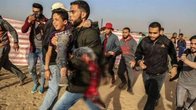
Since 1 April, Médecins Sans Frontières (MSF) teams in Gaza have provided post-operative care to more than 500 people injured by Israeli gunshots, during the Great March of Return demonstrations.
The number of patients treated in MSF clinics, over the last three weeks, is more than the number they treated throughout all of 2014, when Israel’s military offensive was launched over the Gaza Strip.
MSF medical staff report receiving patients with devastating injuries of an unusual severity, which are extremely complex to treat. The injuries sustained by patients will leave most with serious, long-term physical disabilities.
Medical teams in Gaza hospitals prepare to face a possible new influx of wounded every Friday until the last 15 May, when the Great March of Return demonstrations reach the peak as planned by organisers.
MSF surgeons in Gaza report devastating gunshot wounds among hundreds of people injured during the protests over recent weeks.
The huge majority of patients – mainly young men, but also some women and children – have unusually severe wounds to the lower extremities.
‘Minced bones’
MSF medical teams note the injuries include an extreme level of destruction to bones and soft tissue, and large exit wounds that can be the size of a fist.
“Half of the more than 500 patients we have admitted in our clinics have injuries where the bullet has literally destroyed tissue after having pulverised the bone”, said Marie-Elisabeth Ingres, Head of Mission of MSF in Palestine. “These patients will need to have very complex surgical operations and most of them will have disabilities for life.”
Managing these injuries is very difficult. Apart from regular nursing care, patients will often need additional surgery, and undergo a very long process of physiotherapy and rehabilitation.
A lot of patients will keep functional deficiencies for the rest of their life. Some patients may yet need amputation if not provided with sufficient care in Gaza and if they do not manage to get the necessary authorisation to be treated outside of the strip.
More staff needed
To face this massive influx of patients, MSF has reinforced its capacities, increased the number of beds in its post-operative clinics and recruited and trained additional medical staff.
A fourth clinic will open soon, in the Middle-Area region of Gaza, to provide patients with the necessary specialised care.
In response to the crisis, MSF has also deployed a team of surgeons, including vascular, orthopedic and reconstructive surgeons, as well as anesthesiologists to operate – or re-operate – on the more severe cases.
This team currently works side-by-side with Palestinian medical staff in Al-Shifa and Al-Aqsa public hospitals.
The number of patients treated in MSF clinics, over the last three weeks, is more than the number they treated throughout all of 2014, when Israel’s military offensive was launched over the Gaza Strip.
MSF medical staff report receiving patients with devastating injuries of an unusual severity, which are extremely complex to treat. The injuries sustained by patients will leave most with serious, long-term physical disabilities.
Medical teams in Gaza hospitals prepare to face a possible new influx of wounded every Friday until the last 15 May, when the Great March of Return demonstrations reach the peak as planned by organisers.
MSF surgeons in Gaza report devastating gunshot wounds among hundreds of people injured during the protests over recent weeks.
The huge majority of patients – mainly young men, but also some women and children – have unusually severe wounds to the lower extremities.
‘Minced bones’
MSF medical teams note the injuries include an extreme level of destruction to bones and soft tissue, and large exit wounds that can be the size of a fist.
“Half of the more than 500 patients we have admitted in our clinics have injuries where the bullet has literally destroyed tissue after having pulverised the bone”, said Marie-Elisabeth Ingres, Head of Mission of MSF in Palestine. “These patients will need to have very complex surgical operations and most of them will have disabilities for life.”
Managing these injuries is very difficult. Apart from regular nursing care, patients will often need additional surgery, and undergo a very long process of physiotherapy and rehabilitation.
A lot of patients will keep functional deficiencies for the rest of their life. Some patients may yet need amputation if not provided with sufficient care in Gaza and if they do not manage to get the necessary authorisation to be treated outside of the strip.
More staff needed
To face this massive influx of patients, MSF has reinforced its capacities, increased the number of beds in its post-operative clinics and recruited and trained additional medical staff.
A fourth clinic will open soon, in the Middle-Area region of Gaza, to provide patients with the necessary specialised care.
In response to the crisis, MSF has also deployed a team of surgeons, including vascular, orthopedic and reconstructive surgeons, as well as anesthesiologists to operate – or re-operate – on the more severe cases.
This team currently works side-by-side with Palestinian medical staff in Al-Shifa and Al-Aqsa public hospitals.
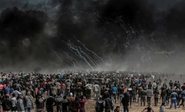
The European Union (EU) has called for the opening of a full investigation regarding the killing of Palestinian demonstrators by Israeli forces along the Gaza Strip’s borders, on Friday.
The EU mentioned, in a press release, that the soldiers used live bullets intensively, leading to the death of 4 demonstrators, including a child, while hundreds have been wounded.
High Representative of the Union for Foreign Affairs and Security Policy / Vice-President of the Commission, Federica Mujerini, called to end the escalation in the Palestinian territories and to provide an explanation for the violent incidents against Palestinians demonstrators which led to the deaths of some of them.
The EU urged the Israeli army to stop using the lethal force against the unarmed Palestinian demonstrators, adding that the priority, now, is to avoid another escalation of violence that will lead to more loss of life.
Four Palestinians, including a child, were killed last Friday and 729 Palestinians were injured because of Israeli suppression of the peaceful demonstrations along the eastern border of Gaza Strip. Therefore, the number of Palestinian deaths has been raised to 37, since the beginning of the Great Return March.
According to Al Ray, Palestinians are continuing with the Great Return March, which began on the 30th of March, on the eastern border of Gaza Strip. It will culminate on the 15th of May, the anniversary of the Palestinian Nakba, whereupon the Palestinians will demand the return to their homes from which they were displaced in 1948.
The EU mentioned, in a press release, that the soldiers used live bullets intensively, leading to the death of 4 demonstrators, including a child, while hundreds have been wounded.
High Representative of the Union for Foreign Affairs and Security Policy / Vice-President of the Commission, Federica Mujerini, called to end the escalation in the Palestinian territories and to provide an explanation for the violent incidents against Palestinians demonstrators which led to the deaths of some of them.
The EU urged the Israeli army to stop using the lethal force against the unarmed Palestinian demonstrators, adding that the priority, now, is to avoid another escalation of violence that will lead to more loss of life.
Four Palestinians, including a child, were killed last Friday and 729 Palestinians were injured because of Israeli suppression of the peaceful demonstrations along the eastern border of Gaza Strip. Therefore, the number of Palestinian deaths has been raised to 37, since the beginning of the Great Return March.
According to Al Ray, Palestinians are continuing with the Great Return March, which began on the 30th of March, on the eastern border of Gaza Strip. It will culminate on the 15th of May, the anniversary of the Palestinian Nakba, whereupon the Palestinians will demand the return to their homes from which they were displaced in 1948.
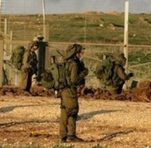
Israeli snipers stationed at the Gaza borders, Sunday, fired live ammunition at two Palestinian youth during ongoing protests east of Khan Younis, in the south of the Gaza Strip.
Medical sources said that Israeli snipers shot the two youth in their feet. Their medical condition was described at moderate.
East of Gaza city, Israeli soldiers used live ammunition and fired teargas canisters at unarmed protesters, injuring one youth with a bullet in his leg. His condition was also described as moderate, according to WAFA.
Protests along the Gaza borders continue for the fourth week in a row, as part of the Great March of Return.
Medical sources said that Israeli snipers shot the two youth in their feet. Their medical condition was described at moderate.
East of Gaza city, Israeli soldiers used live ammunition and fired teargas canisters at unarmed protesters, injuring one youth with a bullet in his leg. His condition was also described as moderate, according to WAFA.
Protests along the Gaza borders continue for the fourth week in a row, as part of the Great March of Return.
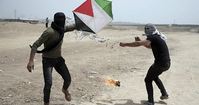
A warehouse in Israel’s south was reportedly went on fire overnight Friday after a kite equipped with incendiary material, which had been released by Palestinian protesters in the Gaza Strip, landed there.
According to Yedioth Ahronoth news website, the kite was affixed with a Molotov cocktail or a flaming rag and caused a fire at an agricultural warehouse in an Israeli settlement community near the border.
Firefighters managed to control the fire, but the storage depot sustained considerable damage.
According to Yedioth Ahronoth news website, the kite was affixed with a Molotov cocktail or a flaming rag and caused a fire at an agricultural warehouse in an Israeli settlement community near the border.
Firefighters managed to control the fire, but the storage depot sustained considerable damage.
